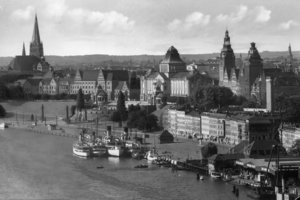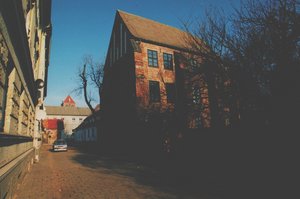History of the Collections
Even though the Pomeranian State Museum is young – the foundation was established in 1996 – the collections have a long history. Primarily, these include the Szczecin Painting Collection, the Pomeranian Foundation in Kiel, and the collection of the Greifswald City Museum.
The total holdings comprise about 60,000 objects from 14,000 years of history. Only a fraction of these holdings is presented at the exhibitions. Among the highlights of the important art collection are paintings by Frans Hals, Caspar David Friedrich, Vincent van Gogh, and Emil Nolde. In addition to the museum’s own holdings, our exhibitions feature loans from various other German, Swedish, and Polish partners. One highlight is the legendary Croy Tapestry, which has been the property of the University of Greifswald for centuries.
Szczecin 1913–1945
The beginnings of our museum’s collections in Szczecin date back to the first half of the 19th century. In 1834, the Art Association for Pomerania was founded, and it acquired works for its painting collection. Donations and bequests from art-loving citizens gradually increased the holdings. In 1913, the representative new museum building on Hakenterrasse was opened. Heinrich Dohrn (1838–1913), who came from a family of Szczecin factory owners and was a passionate promoter of art and science, was the main source of inspiration. Through the mediation of the Dohrn family, Walter Riezler (1878–1965) of Munich was appointed the first director of the art collection in 1910. He gave the collection a distinctive profile and purchased modernist works – sometimes against considerable resistance. Under National Socialism, Riezler was ousted in 1934 and Otto Holtze took over as director. In the wake of the “Degenerate Art” campaign, the collection lost some of its most important works.
As the front approached in 1945, two railway wagons were used to transfer about 200 paintings and some of the graphic art from Szczecin (then German Stettin) to Coburg, where the mayor of Stettin (and numerous other Nazi functionaries) hailed from. On 21 March, under the direction of the city librarian Wilhelm Eggebrecht, the evacuation began.
Coburg 1945–1970
After a train journey of several days, Eggebrecht arrived in Coburg with his treasures. The paintings had just been temporarily housed in a school when a bomb hit the building. However, most of the paintings remained undamaged.
For security reasons, the American military administration moved the Szczecin museum property to Tambach Castle near Coburg. After the end of the war, the paintings were brought to Munich via the “Central Collecting Point” in Wiesbaden; but in 1956, they were gradually returned to the city of Coburg and, beginning in 1962, were presented there in the rooms of the art collections of the Veste Coburg.
Pomerania Foundation in Kiel 1966–2000
The state of Schleswig-Holstein had been Pomerania’s sponsor since 1954. In 1966, the state parliament passed a law establishing the Pomerania Foundation, whose task was to preserve Pomeranian cultural assets. From the 1970s onwards, the foundation built up a collection of Pomeranian art and cultural history, consisting mainly of photographs, maps, and handwritten documents, but also coins and medals. In addition, there was an extensive library. Important holdings were, for example, the Rabl-Virchow and Doering collections.
In 1969, the Prussian Cultural Heritage Foundation entrusted the Pomerania Foundation in Kiel with the care of the Szczecin art collection. This decision triggered some fierce protests in Coburg; lengthy negotiations followed. At the end of 1970, however, the Szczecin paintings and graphic works were able to embark on their journey to Kiel. The Rantzau Building of Kiel Castle became their new home.
But what no one could have foreseen at the time: The collection was to change its location once again – to the newly founded Pomeranian State Museum. In December 1999, the paintings were transferred from Kiel to Greifswald, where they were combined with the holdings of the Museum of the Hanseatic City of Greifswald and the University. Thus, the paintings returned to Pomerania. In 2000, the Pomeranian Foundation in Kiel was dissolved, and the remaining holdings were also transferred to the Pomeranian State Museum.
Museum foundation in the early 20th century
The initiative to found the Greifswald Museum came from the University of Greifswald and the Art Association. In October 1918, during renovation work in the town hall, three maps from the 17th and 18th centuries were found, among them the Lubin map of Pomerania, which had been commissioned by Duke Philipp II in 1618. They formed the basis of the collection. In 1927, the university handed over finds from the Eldena Monastery Church. After some provisional arrangements, in 1928 the move to the final location took place: to the Monastery Library of the Franciscan monastery (previously known as the “Guardianshaus”), which today is part of the Pomeranian State Museum. In the winter of 1928/29, the collection had already grown to over 2000 objects. The ceremonial reopening took place on 23 June 1929. In his inaugural lecture, the museum’s first director, Adolf Kreutzfeldt, designated the areas for the museum’s collection and research to include the Eldena Monastery, the history of the city and the university, including its folklore department, and the fields of agriculture and fisheries.
Expansion of the city’s art collection
The purchase, in 1934, of the painting “Eldena Ruin in the Giant Mountains” by Caspar David Friedrich, probably the city’s most famous son, marked the starting point for the development of a collection of international significance. Contemporary art was also collected. In 1937, art was confiscated as part of the “Degenerate Art” campaign. During the Second World War, parts of the coin and graphic art collection as well as works by Caspar David Friedrich were moved to the Greifswald Savings Bank in 1941, where they were protected from shrapnel and fire. In 1942, additional objects were evacuated to Quitzin Castle west of Grimmen, and, in 1943, to Schmoldow Manor south of Greifswald. Large parts of the collection were irretrievably lost.
A milestone was the purchase, in 1951, of the watercolour “The Greifswald Market Place” by Caspar David Friedrich. Despite modest means, the directors Sigrid Hinz (1955–1956) and Ursula Meyer (1959–1969) were able to significantly expand the collection, including some of Caspar David Friedrich’s contemporaries, such as Wilhelm Titel, Johann Friedrich Boeck, and Christian Johann Gottlieb Giese. From the 1960s onwards, the collection primarily acquired works by artists from the region, such as Otto Niemeyer-Holstein and Herbert Wegehaupt. The collections of the City Museum were transferred in their entirety to the Pomeranian State Museum in 2000.
New acquisitions since 1996
The Pomeranian State Museum Foundation’s statutes firmly anchor the collection’s mission to preserve and document the art, history, and culture of the historical province of Pomerania. Even though purchases can only be realised to a small extent from third-party funding, the collections have been continuously expanding since the foundation was established, particularly thanks to supplementary and enriching donations. For example, with the help of the Cultural Foundation of the German Federal States and other donors, it was possible to acquire for the gallery the painting “Świnoujście by Moonlight” (“Swinemünde an der Oder im Mondschein”) by Johan Christian Dahl, a Norwegian friend of Caspar David Friedrich, and the magnificently decorated Vase of Eldena for the exhibition on regional history.


